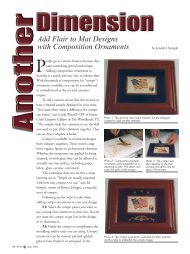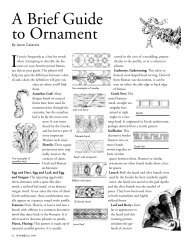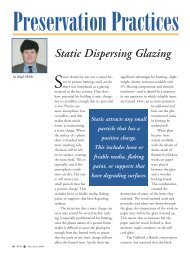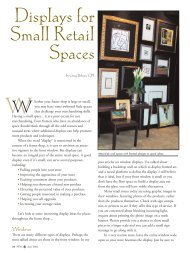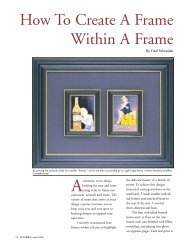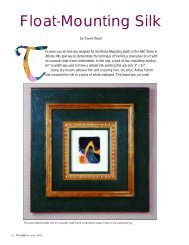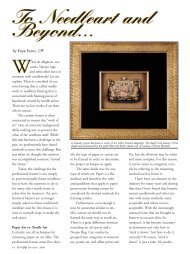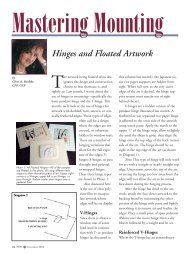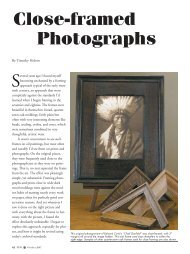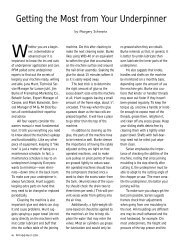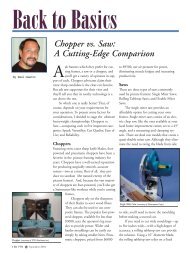TABLE OF CONTENTS - Picture Framing Magazine
TABLE OF CONTENTS - Picture Framing Magazine
TABLE OF CONTENTS - Picture Framing Magazine
You also want an ePaper? Increase the reach of your titles
YUMPU automatically turns print PDFs into web optimized ePapers that Google loves.
which have expanding wings which will<br />
open after the end of the bolt is slipped<br />
through a hole in the dry wall is the obvious<br />
choice. These bolts can be used as<br />
hangers with a section of their length left<br />
exposed so that wires which extend vertically<br />
up form hangers on the back of<br />
the frame can be slipped over them.<br />
There are numerous security hangers<br />
on the market which should deter all<br />
but the most determined thieves. If time<br />
does not permit of the acquisition of<br />
such hangers, simple substitutes can be<br />
made from mending plates or screw type<br />
hardware for sectional frames. The brass<br />
mending plates can be screwed to the<br />
back of the frame along its top member,<br />
near the corners, and to the center of the<br />
back of the bottom member.<br />
The screws which are used to<br />
secure the exposed holes of the<br />
mending plates to the wall can<br />
be covered with spackling compound<br />
and painted to disguise<br />
their method of removal. If a<br />
sectional frame is being hung,<br />
the screw type hangers can be<br />
installed in reverse, so that the<br />
wire hole appears on the outside<br />
of the frame. These, too,<br />
should be placed on the top and<br />
bottom of the frame so that they<br />
will be as invisible as possible. Any thief<br />
who is willing to simply rip the frame off<br />
the will be risking the destruction of its<br />
contents and is difficult to guard against.<br />
THE ROLE <strong>OF</strong> FRAMING IN PRESERVATION<br />
Having touched on some of the problems<br />
and solutions in framing, it must be<br />
asked, how does framing fit into preservation?<br />
Frames which existed for works<br />
of art on paper up to the middle of this<br />
century could only be described as slowly<br />
destructive. The advent of rag and<br />
alphacellulose boards meant that the art<br />
would not be exposed to the ravages of<br />
degrading lignin. The availability of<br />
ultraviolet filtration rendered protection<br />
to the cellulose in the paper and to some<br />
of the media and to some pigments and<br />
dyes from light damage. The replacement<br />
of animal hide and dextrine glues<br />
with vegetable starch paste made<br />
reversibility in hinging practicable and<br />
stopped the discoloration of the paper<br />
which the glues caused. Today we are<br />
moving into an era in which the framer<br />
can work with effective barriers and<br />
scavengers to sequester the art from pollution<br />
and excessive variations in<br />
humidity. How does today’s frame compare<br />
to the storage box which sits on the<br />
shelf in an institution?<br />
One salient difference is the orientation<br />
of the art work. In the frame the art<br />
TODAY WE ARE MOVING INTO AN ERA IN<br />
WHICH THE FRAMER CAN WORK WITH<br />
EFFECTIVE BARRIERS AND SCAVENGERS TO<br />
SEQUESTER THE ART FROM POLLUTION AND<br />
EXCESSIVE VARIATIONS IN HUMIDITY.<br />
will be vertical, while it will be horizontal<br />
in the storage box. This means that<br />
gravity will hold it flat in box whether it<br />
is overmatted or floated. In the frame,<br />
gravity will not have a very great impact<br />
on an overmatted work on paper since<br />
the gentle pressure of the window mat<br />
will hold it in plane. A floated work on<br />
paper will likely suffer more from the<br />
long term effect of gravity since it will<br />
only be supported by its hinges. The<br />
unrestrained edges of the work will likely<br />
bend in response to changes to relative<br />
humidity and it may cockle more<br />
than if it were stored flat. Media such as<br />
pastel, chalk, graphite, or paint films<br />
which have cracked may also experience<br />
a loss of some of their particles as they<br />
are pulled down by gravity. This can be<br />
especially problematical if the loosened<br />
particles dislodge and settle on another<br />
p a rt of the art, blurring its design.<br />
Indeed, resettling particles are a more<br />
troublesome problem than those which<br />
come off onto the glazing, since the latter<br />
will cause a minuscule lightening of<br />
the image but they will not blur it.<br />
The other important diff e re n c e<br />
between the storage box and the frame is<br />
the light which the latter permits to fall<br />
on the art. The exclusion of a great<br />
degree of ultraviolet light with a filtering<br />
glazing will greatly benefit the cellulose<br />
in the paper and should slow the degradation<br />
of any lignin, but it will<br />
only provide support for some<br />
of the colors.<br />
An owner who truly cares<br />
about a work and chooses to<br />
frame it can help it survive<br />
through continuous control of<br />
the light which falls on the<br />
frame. If the frame is hung in<br />
an interior hall way or a room<br />
which has light excluding window<br />
blinds which are kept shut<br />
except when the room is being<br />
used, the light damage can be<br />
minimized. If a decorating scheme calls<br />
for something to face a glass wall or a<br />
skylight, it should only be something<br />
which is truly expendable or totally<br />
lightfast. Thus, some of the responsibility<br />
must be placed on the owner. A consideration<br />
of the issue of why should<br />
light fall on a frame when no one looking<br />
at it may help to inform the owners hanging<br />
plans.<br />
The storage box is usually in an<br />
area which has the best possible climate<br />
and is aided by the mass of similar material<br />
which surrounds it. A box which is<br />
filled which matted art will have a resistance<br />
to changes in relative humidity



